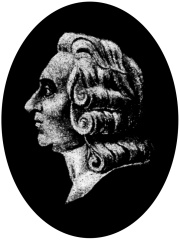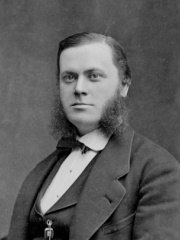
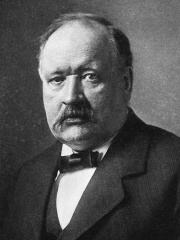
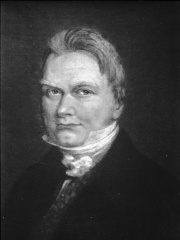
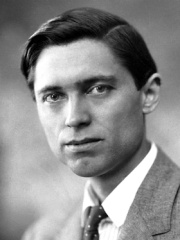
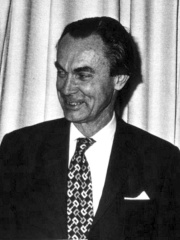
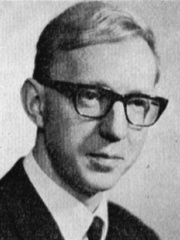
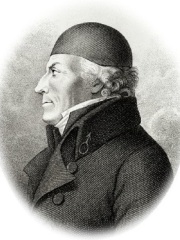
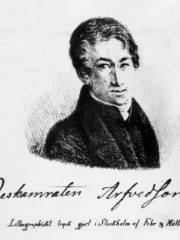
The Most Famous
CHEMISTS from Sweden
Top 10
The following people are considered by Pantheon to be the top 10 most legendary Swedish Chemists of all time. This list of famous Swedish Chemists is sorted by HPI (Historical Popularity Index), a metric that aggregates information on a biography's online popularity. Visit the rankings page to view the entire list of Swedish Chemists.

1. Alfred Nobel (1833 - 1896)
With an HPI of 88.86, Alfred Nobel is the most famous Swedish Chemist. His biography has been translated into 159 different languages on wikipedia.
Alfred Bernhard Nobel (21 October 1833 – 10 December 1896) was a Swedish chemist, inventor, engineer, and businessman. He is known for inventing dynamite, as well as having bequeathed his fortune to establish the Nobel Prizes. He also made several other important contributions to science, holding 355 patents during his life. Born into the prominent Nobel family in Stockholm, Nobel displayed an early aptitude for science and learning, particularly in chemistry and languages; he became fluent in six languages and filed his first patent at the age of 24. He embarked on many business ventures with his family, most notably owning the company Bofors—which was an iron and steel producer that he had developed into a major manufacturer of cannons and other armaments. Nobel's most famous invention, dynamite, was an explosive made using nitroglycerin, which was patented in 1867. He further invented gelignite in 1875 and ballistite in 1887. Upon his death, Nobel donated his fortune to a foundation to fund the Nobel Prizes, which annually recognize those who have "conferred the greatest benefit to humankind". The synthetic element nobelium was named after him, and his name and legacy also survive in companies such as Dynamit Nobel and AkzoNobel, which descend from mergers with companies he founded. Nobel was elected a member of the Royal Swedish Academy of Sciences, which, pursuant to his will, is responsible for choosing the Nobel laureates in Physics and in Chemistry.

2. Svante Arrhenius (1859 - 1927)
With an HPI of 80.55, Svante Arrhenius is the 2nd most famous Swedish Chemist. His biography has been translated into 93 different languages.
Svante August Arrhenius ( ə-REE-nee-əs, -RAY-, Swedish: [ˈsvânːtɛ aˈrěːnɪɵs]; 19 February 1859 – 2 October 1927) was a Swedish scientist. Originally a physicist, but often referred to as a chemist, Arrhenius was one of the founders of the science of physical chemistry. In 1903, he received the Nobel Prize in Chemistry, becoming the first Swedish Nobel laureate. In 1905, he became the director of the Nobel Institute, where he remained until his death. Arrhenius was the first to use the principles of physical chemistry to estimate the extent to which increases in the atmospheric carbon dioxide are responsible for the Earth's increasing surface temperature. His work played an important role in the emergence of modern climate science. In the 1960s, Charles David Keeling reliably measured the level of carbon dioxide present in the air showing it was increasing and that, according to the greenhouse hypothesis, it was sufficient to cause significant global warming. The Arrhenius equation, Arrhenius acid, Arrhenius base, lunar crater Arrhenius, Martian crater Arrhenius, the mountain of Arrheniusfjellet, and the Arrhenius Labs at Stockholm University were so named to commemorate his contributions to science.

3. Jöns Jacob Berzelius (1779 - 1848)
With an HPI of 80.13, Jöns Jacob Berzelius is the 3rd most famous Swedish Chemist. His biography has been translated into 76 different languages.
Baron Jöns Jacob Berzelius (Swedish: [jœns ˈjɑ̌ːkɔb bæˈʂěːlɪɵs]; 20 August 1779 – 7 August 1848) was a Swedish chemist. Berzelius is considered, along with Robert Boyle, John Dalton, and Antoine Lavoisier, to be one of the founders of modern chemistry. Berzelius became a member of the Royal Swedish Academy of Sciences in 1808 and served from 1818 as its principal functionary. He is known in Sweden as the "Father of Swedish Chemistry". During his lifetime he did not customarily use his first given name, and was universally known simply as Jacob Berzelius. Although Berzelius began his career as a physician, his enduring contributions were in the fields of electrochemistry, chemical bonding and stoichiometry. In particular, he is noted for his determination of atomic weights and his experiments that led to a more complete understanding of the principles of stoichiometry, which is the branch of chemistry pertaining to the quantitative relationships between elements in chemical compounds and chemical reactions and that these occur in definite proportions. This understanding came to be known as the "Law of Constant Proportions". Berzelius was a strict empiricist, expecting that any new theory must be consistent with the sum of contemporary chemical knowledge. He developed improved methods of chemical analysis, which were required to develop the basic data in support of his work on stoichiometry. He investigated isomerism, allotropy, and catalysis, phenomena that owe their names to him. Berzelius was among the first to articulate the differences between inorganic compounds and organic compounds. Among the many minerals and elements he studied, he is credited with discovering cerium and selenium, and with being the first to isolate silicon and thorium. Following on his interest in mineralogy, Berzelius synthesized and chemically characterized new compounds of these and other elements. Berzelius demonstrated the use of an electrochemical cell to decompose certain chemical compounds into pairs of electrically opposite constituents. From this research, he articulated a theory that came to be known as electrochemical dualism, contending that chemical compounds are oxide salts, bonded together by electrostatic interactions. This theory, while useful in some contexts, came to be seen as insufficient. Berzelius's work with atomic weights and his theory of electrochemical dualism led to his development of a modern system of chemical formula notation that showed the composition of any compound both qualitatively and quantitatively. His system abbreviated the Latin names of the elements with one or two letters and applied superscripts to designate the number of atoms of each element present in the compound. Later, chemists changed to use of subscripts rather than superscripts.

4. Theodor Svedberg (1884 - 1971)
With an HPI of 74.00, Theodor Svedberg is the 4th most famous Swedish Chemist. His biography has been translated into 64 different languages.
Theodor Svedberg (30 August 1884 – 25 February 1971) was a Swedish chemist and Nobel laureate for his research on colloids and proteins using the ultracentrifuge. Svedberg was active at Uppsala University from the mid-1900s to late 1940s. While at Uppsala, Svedberg started as a docent before becoming the university's physical chemistry head in 1912. After leaving Uppsala in 1949, Svedberg was in charge of the Gustaf Werner Institute until 1967. Apart from his 1926 Nobel Prize, Svedberg was named a Foreign Member of the Royal Society in 1944 and became part of the National Academy of Sciences in 1945.
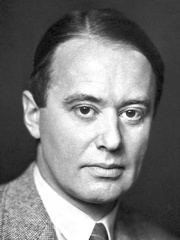
5. Arne Tiselius (1902 - 1971)
With an HPI of 73.79, Arne Tiselius is the 5th most famous Swedish Chemist. His biography has been translated into 63 different languages.
Arne Wilhelm Kaurin Tiselius (10 August 1902 – 29 October 1971) was a Swedish biochemist who won the Nobel Prize in Chemistry in 1948 "for his research on electrophoresis and adsorption analysis, especially for his discoveries concerning the complex nature of the serum proteins."

6. Sune Bergström (1916 - 2004)
With an HPI of 71.74, Sune Bergström is the 6th most famous Swedish Chemist. His biography has been translated into 50 different languages.
Karl Sune Detlof Bergström (10 January 1916 – 15 August 2004) was a Swedish biochemist. In 1975, he was appointed to the Nobel Foundation Board of Directors in Sweden, and was awarded the Louisa Gross Horwitz Prize from Columbia University, together with Bengt I. Samuelsson. He shared the Nobel Prize in Physiology or Medicine with Bengt I. Samuelsson and John R. Vane in 1982, for discoveries concerning prostaglandins and related substances. Bergström was elected a member of the Royal Swedish Academy of Sciences in 1965, and its President in 1983. In 1965, he was also elected a member of the Royal Swedish Academy of Engineering Sciences. He was elected a Foreign Honorary Member of the American Academy of Arts and Sciences in 1966. He was also a member of both the United States National Academy of Sciences and the American Philosophical Society. Bergström was awarded the Cameron Prize for Therapeutics of the University of Edinburgh in 1977. In 1985, he was appointed member of the Pontifical Academy of Sciences. He was awarded the Illis quorum in 1985. In 1943, Bergström married Maj Gernandt. He had two sons, the businessman Rurik Reenstierna, with Maj Gernandt; and the evolutionary geneticist Svante Pääbo (winner of the 2022 Nobel Prize in Physiology or Medicine), from an extramarital affair with Karin Pääbo, an Estonian chemist. Both sons were born in 1955, and Rurik learned about the existence of his half-brother Svante only around 2004.

7. Bengt I. Samuelsson (1934 - 2024)
With an HPI of 71.11, Bengt I. Samuelsson is the 7th most famous Swedish Chemist. His biography has been translated into 48 different languages.
Bengt Ingemar Samuelsson (21 May 1934 – 5 July 2024) was a Swedish biochemist. He shared with Sune K. Bergström and John R. Vane the 1982 Nobel Prize for Physiology or Medicine for discoveries concerning prostaglandins and related substances.

8. Johan Gottlieb Gahn (1745 - 1818)
With an HPI of 68.78, Johan Gottlieb Gahn is the 8th most famous Swedish Chemist. His biography has been translated into 31 different languages.
Johan Gottlieb Gahn (19 August 1745 – 8 December 1818) was a Swedish chemist and metallurgist who isolated manganese in 1774. Gahn studied in Uppsala from 1762 to 1770 and became acquainted with chemists Torbern Bergman and Carl Wilhelm Scheele. 1770 he settled in Falun, where he introduced improvements in copper smelting, and participated in building up several factories, including those for vitriol, sulfur and red paint. He was the chemist for the Swedish Board of Mines from 1773 to 1817. He was very reluctant to publish his scientific findings himself, but freely communicated them to Bergman and Scheele. One of Gahn's discoveries was that manganese dioxide could be reduced to manganese metal using carbon, becoming the first to isolate this element in its metal form. In 1784, Gahn was elected a member of the Royal Swedish Academy of Sciences. He also had a managerial career in Swedish mining.

9. Johan August Arfwedson (1792 - 1841)
With an HPI of 67.55, Johan August Arfwedson is the 9th most famous Swedish Chemist. His biography has been translated into 35 different languages.
Johan August Arfwedson (12 January 1792 – 28 October 1841) was a Swedish chemist who discovered the chemical element lithium in 1817 by isolating it as a salt.

10. Georg Brandt (1694 - 1768)
With an HPI of 66.89, Georg Brandt is the 10th most famous Swedish Chemist. His biography has been translated into 28 different languages.
Georg Brandt (26 June 1694 – 29 April 1768) was a Swedish chemist and mineralogist who discovered cobalt c. 1735. He was the first person to discover a metal unknown in ancient times. He is also known for exposing fraudulent alchemists operating during his lifetime.
People
Pantheon has 20 people classified as Swedish chemists born between 1694 and 1934. Of these 20, none of them are still alive today. The most famous deceased Swedish chemists include Alfred Nobel, Svante Arrhenius, and Jöns Jacob Berzelius.
Deceased Swedish Chemists
Go to all RankingsAlfred Nobel
1833 - 1896
HPI: 88.86
Svante Arrhenius
1859 - 1927
HPI: 80.55
Jöns Jacob Berzelius
1779 - 1848
HPI: 80.13
Theodor Svedberg
1884 - 1971
HPI: 74.00
Arne Tiselius
1902 - 1971
HPI: 73.79
Sune Bergström
1916 - 2004
HPI: 71.74
Bengt I. Samuelsson
1934 - 2024
HPI: 71.11
Johan Gottlieb Gahn
1745 - 1818
HPI: 68.78
Johan August Arfwedson
1792 - 1841
HPI: 67.55
Georg Brandt
1694 - 1768
HPI: 66.89
Axel Fredrik Cronstedt
1722 - 1765
HPI: 66.25
Per Teodor Cleve
1840 - 1905
HPI: 66.00
Overlapping Lives
Which Chemists were alive at the same time? This visualization shows the lifespans of the 19 most globally memorable Chemists since 1700.

